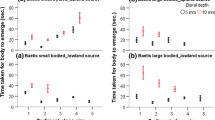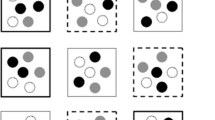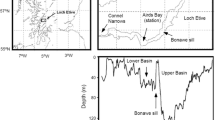Abstract
After a pelagic larval phase, infaunal bivalves undergo metamorphosis and transition to the underlying sediments to begin the benthic stage of their life history, where they explore and then either accept or reject sediments. Although the settlement cues used by juvenile infaunal bivalves are poorly understood, here we provide evidence that carbonate saturation state is a significant chemical cue in both direct observation laboratory studies and field manipulations. In the laboratory, plantigrade-stage Mercenaria mercenaria (200 μm shell height) showed a significant positive relationship between percent burrowed and Ωaragonite, with an increasing probability of settlement with increasing saturation state. In the field, we increased bivalve recruitment by a factor of three in a 30-day field study by raising the pH (∼0.3) and saturation state of surface sediments by buffering sediments with crushed shell (CaCO3). The susceptibility of infaunal bivalves to dissolution mortality and the tight coupling of other sedimentary biogeochemical processes with carbonate dynamics suggest that mineral thermodynamics may be an overarching cue new settlers are responding to.





Similar content being viewed by others
References
Aller, R.C. 1982. Carbonate dissolution in nearshore terrigenous muds: the role of physical and biological reworking. Journal of Geology 90: 79–95.
Armonies, W. 1996. Changes in distribution patterns of O-group bivalves in the Wadden Sea; Byssus-drifting releases juveniles from the constraints of hydrography. Journal of Shellfish Research 35(4): 323–334.
Ayers, J. 1956. Population dynamics of the marine clam, Mya arenaria. Limnology and Oceanography 1(1): 26–34.
Bowen, J., and H. Hunt. 2009. Settlement and recruitment patterns of the soft shell clam, Mya arenaria, on the northern shore of Bay of Fundy, Canada. Estuaries and Coasts 32: 758–72.
Brecevic, N. 1989. Solubility of amorphous calcium carbonate. Journal of Crystal Growth 98: 504–510.
Butman, C.A., J.P. Grassle, and C.M. Webb. 1988. Substrate choices made by marine larvae settling in still water and in a flume flow. Nature 333: 771–773.
Carriker, M.R. 1961. Interrelations of functional morphology, behavior, and autecology in early stages of the bivalve Mercenaria mercenaria. Journal of the Elisha Mitchell Scientific Society 77(2): 168–241.
Carriker, M.R. 2001. Functional morphology and behavior of veligers and early juveniles. In Biology of the hard clam, ed. J. Kraeuther and M. Castagna, 283–303. New York: Elsevier.
Cummings, V., K. Vopel, and S. Thrush. 2009. Terrigenous deposits in coastal marine habitats: influences on sediment geochemistry and behavior of post settlement bivalves. Marine Ecology Progress Series 383: 173–185.
Dickson, A.G., and F.J. Millero. 1987. A comparison of the equilibrium constants for the dissociation of carbonic acid in seawater media. Deep Sea Research 34: 1733–1743.
Edmond, J.M. 1970. High precision determination of titration alkalinity and total carbon dioxide content of seawater by potentiometric titration. Deep Sea Research 17: 737–750.
Emerson, C.W., and J. Grant. 1991. The control of soft shell clam (Mya arenaria) recruitment on inter-tidal sandflats by bedload sediment transport. Limnology and Oceanography 36(7): 1288–1300.
Engstrom, S., and R. Marinelli. 2005. Recruitment responses of benthic infauna to manipulated sediment geochemical properties in natural flows. Journal of Marine Research 63: 407–36.
Feely, R.A., C. Sabine, K. Lee, W. Berelson, J. Kleypas, V. Fabry, and F. Millero. 2004. Impact of anthropogenic CO2 on the CaCO3 system in the oceans. Science 305(5682): 362–366.
Fritz, L.W. 2001. Shell structure and age determination. In Biology of the hard clam, ed. J.N. Kraeuter and M. Castagna, 53–76. Amsterdam: Elsevier.
Gallager, S.M., R. Mann, and G.C. Sasaki. 1986. Lipid as an index of growth and viability in three species of bivalve larvae. Aquaculture 56: 81–103.
Gosselin, L.A., and P. Qian. 1997. Juvenile mortality in benthic marine invertebrates. Marine Ecology Progress Series 146: 265–282.
Green, M.A., and R.C. Aller. 1998. Seasonal patterns of carbonate diagenesis in nearshore terrigenous muds: relation to spring phytoplankton bloom and temperature. Journal of Marine Research 56: 1097–1123.
Green, M.A., and R.C. Aller. 2001. Early diagenesis of calcium carbonate in Long Island Sound sediments: benthic fluxes of Ca2+ and minor elements during seasonal periods of net dissolution. Journal of Marine Research 59: 769–94.
Green, M.A., J. Gulnick, N. Dowse, and P. Chapman. 2004a. Spatio-temporal patterns of carbon remineralization and bio-irrigation in sediments of Casco Bay Estuary, Gulf of Maine. Limnology and Oceanography 49(2): 396–407.
Green, M.A., M.E. Jones, C.L. Boudreau, R.L. Moore, and B.A. Westman. 2004b. Dissolution mortality of juvenile bivalves in coastal marine deposits. Limnology and Oceanography 49(3): 727–734.
Green, M.A., G. Waldbusser, S. Reilly, K. Emerson, and S. O’Donnell. 2009. Death by dissolution: sediment saturation state as a mortality factor for juvenile bivalves. Limnology and Oceanography 54(4): 1037–47.
Gutierrez, J.L., C.G. Jones, D.L. Strayer, and O.O. Iribarne. 2003. Mollusks as ecosystem engineers: the role of shell production in aquatic habitats. Oikos 101: 79–90.
Holcomb, M., A.L. Cohen, and D.C. McCorkle. 2012. An investigation of the calcification response of the scleractinian coral Astrangia poculata to elevated pCO2 and the effects of nutrients, zooxanthellae and gender. Biogeosciences 9: 29–39.
Hunt, H.L., and R.E. Scheibling. 1997. Role of early post-settlement mortality in recruitment of benthic marine invertebrates. Marine Ecology Progress Series 155: 269–301.
Hunt, H.L., M.-J. Maltais, D. Fugate, and R.J. Chant. 2007. Spatial and temporal variability in juvenile bivalve dispersal: effects of sediment transport and flow regime. Marine Ecology Progress Series 352: 145–49.
Kelly, R.P., M.M. Foley, W.S. Fisher, R.A. Feely, B.S. Halpern, G.G. Waldbusser, and M.R. Caldwell. 2011. Mitigating local causes of ocean acidification with existing laws. Science 332: 1036–1037.
Kudo, M., J. Kameda, K. Saruwatari, N. Ozaki, K. Okano, H. Nagasawa, and T. Kogure. 2010. Microtexture of larval shell of oyster, Crassostrea nippona: a FIB-TEM study. Journal of Structural Biology 169: 1–5.
Lundquist, C.J., C.A. Pilditch, and V.J. Cummings. 2004. Behaviour controls post-settlement dispersal by the juvenile bivalves Austrovenus stutchburyi and Macomona liliana. Journal of Experimental Marine Biology and Ecology 306: 51–74.
Mackin, J., and K.T. Swider. 1989. Organic matter decomposition pathways and oxygen consumption in coastal marine sediments. Journal of Marine Research 47: 681–716.
Marinelli, R.L., and S.A. Woodin. 2002. Experimental evidence for linkages between infaunal recruitment, disturbance, and sediment surface chemistry. Limnology and Oceanography 47: 221–29.
Marinelli, R.L., and S.A. Woodin. 2004. Disturbance and recruitment: a test of solute and substrate specificity using Mercenaria mercenaria and Capitella sp. 1. Marine Ecology Progress Series 269: 209–221.
McNichol, A.P., C. Lee, and E. Druffel. 1988. Carbon cycling in coastal sediments: a quantitative estimate of the remineralization of organic carbon in the sediments of Buzzards Bay, MA. Geochimica et Cosmochimica Acta 52: 1531–43.
Mehrbach, C., J.E. Culberson, J.E. Hawley, and R.M. Pytkowicz. 1973. Measurements of apparent dissociation constants of carbonic acid in seawater at atmospheric-pressure. Limnology and Oceanography 18: 897–907.
Moller, P. 1986. Physical factors and biological interactions regulating infauna in shallow boreal areas. Marine Ecology Progress Series 30: 33–47.
Morse, J. 1983. The kinetics of calcium carbonate dissolution and precipitation. Reviews in Mineralogy 11: 227–264.
Norkko, A., V.J. Cummings, S.F. Thrush, J.E. Hewitt, and T. Hume. 2001. Local dispersal of juvenile bivalves: implications for sandflat ecology. Marine Ecology Progress Series 212: 131–144.
Pawlik, J.R. 1992. Chemical ecology of the settlement of benthic marine-invertebrates. Oceanography and Marine Biology 30: 273–335.
Powell, E.N., and J.M. Klinck. 2007. Is oyster shell a sustainable estuarine resource? Journal of Shellfish Research 26: 181–194.
Rasmussen, H., and B.B. Jørgensen. 1992. Microelectrode studies of seasonal oxygen uptake in a coastal sediment: role of molecular diffusion. Marine Ecology Progress Series 81: 289.
Richards, M.G., M. Huxman, and A. Bryant. 1999. Predation: a causal mechanism for variability in intertidal bivalve populations. Journal of Experimental Marine Biology and Ecology 241: 159–77.
Rodriguez, S.R., F.P. Ojeda, and N.C. Inestrosa. 1993. Settlement of benthic marine-invertebrates. Marine Ecology Progress Series 97: 193–207.
Roegner, C., C. Andre, M. Lindegarth, J.E. Eckman, and J. Grant. 1995. Transport of recently settled soft-shell clams (Mya arenaria L.) in laboratory flume flow. Journal of Experimental Marine Biology and Ecology 187: 13–26.
Rude, P.D., and R.C. Aller. 1991. Fluorine mobility during early diagenesis of carbonate sediment: an indicator of mineral transformations. Geochimica et Cosmochimica Acta 55: 2491–2509.
Schöne, B.R., and O. Giere. 2005. Growth increments and stable isotope variation in shells of the deep-sea hydrothermal vent bivalve mollusk Bathymodiolus brevior from the North Fiji Basic, Pacific Ocean. Deep Sea Research Part I: Oceanographic Research Papers 52: 1896–1910.
Sokal, R.R., and F.J. Rohlf. 1995. Biometry: the principles and practice of statistics in biological research, 3rd ed, 887. New York: W. H. Freeman and Co.
Talmage, S., and C.J. Gobler. 2010. Effects of past, present, and future ocean carbon dioxide concentrations on the growth and survival of larval shellfish. Proceedings of the National Academy of Sciences of the United States of America 107: 17246–17251.
Valanko, S., A. Norkko, and J. Norkko. 2010. Strategies of post-larval dispersal in non-tidal soft-sediment communities. Journal of Experimental Marine Biology and Ecology 384: 51–60.
Waldbusser, G.G., H. Bergscheider, and M.A. Green. 2010. Size-dependent effect of pH on calcification in post-larval hard clam Mercenaria mercenaria. Marine Ecology Progress Series 417: 171–182.
Walter, L.M., and E.A. Burton. 1990. Dissolution of recent platform carbonate sediments in marine pore fluids. American Journal of Science 290: 601–43.
Weiss, I., N. Tuross, L. Addadi, and S. Weiner. 2002. Mollusc larval shell formation: amorphous calcium carbonate is a precursor phase for aragonite. The Journal of Experimental Zoology 293: 478–491.
Woodin, S.A. 1998. Process-specific cues for recruitment in sedimentary environments: geochemical signals? Journal of Marine Research 56: 535–558.
Woodin, S.A., S.M. Lindsay, and D.S. Wethey. 1995. Process-specific recruitment cues in marine sedimentary systems. Biology Bulletin 189: 49–58.
Zwarts, L., and J. Wanink. 1989. Siphon size and burying depth in deposit—and suspension-feeding benthic bivalves. Marine Biology 100: 227–40.
Author information
Authors and Affiliations
Corresponding author
Rights and permissions
About this article
Cite this article
Green, M.A., Waldbusser, G.G., Hubazc, L. et al. Carbonate Mineral Saturation State as the Recruitment Cue for Settling Bivalves in Marine Muds. Estuaries and Coasts 36, 18–27 (2013). https://doi.org/10.1007/s12237-012-9549-0
Received:
Revised:
Accepted:
Published:
Issue Date:
DOI: https://doi.org/10.1007/s12237-012-9549-0




